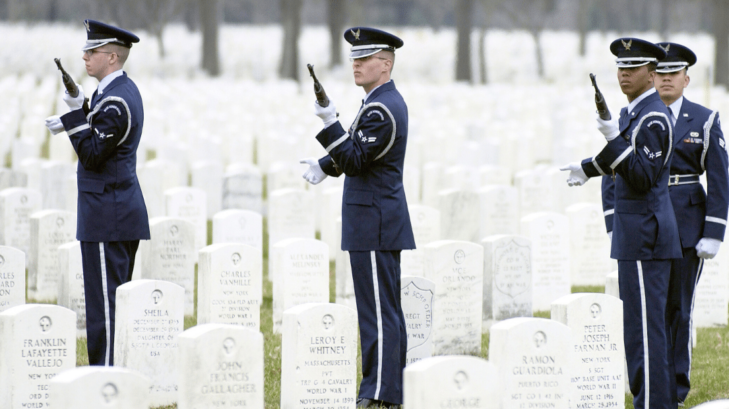If you have ever been to a military funeral or watched one on TV or in the movies, you will know that every part of the service has meaning behind it.
Every military service includes playing “Taps,” which has been regarded as “the most appropriate and touching part of a military funeral.”
RELATED: John Wayne Narrates The History Of “Taps”
After “Taps” is played, the flag that has been lying on top of the casket is folded 13 times to represent the 13 original colonies and handed to the next of kin or close friend if there is no next of kin.

Occasionally, but not always, there will also be a gun salute.
What is the history behind a gun salute at military funerals?
According to the U.S. Army Center of Military History, the gun salute was first used to honor “early warriors who demonstrated their peaceful intentions by placing their weapons in a position that rendered them ineffective.”
Firearm salutes can be traced back to the 14th century when firearms and cannons became more prevalent in the military. Back then, it was just a single discharge.
When warships adopted the gun salute, they chose to fire a seven-gun salute due to the seven days of the week created by God.
Eventually, the land provided better access to gunpowder and lasted longer than it would have at sea, so three were made simultaneously on land for every shot made at sea. This became the 21-gun salute and it “became the highest honor a nation rendered.”

The 21-gun salute was used mostly at sea until the late 1800s.
In 1810, the United States War Department announced that the “national salute” would be equal to the number of states in the Union at the time. In 1810, there were 17 states, so there would be 17 salutes.
Every U.S. military installment fired 17 salutes at 1 PM on Independence Day, and the president also received this salute whenever visiting a military installment.
In 1842, the Presidential salute and “national salute” was changed to 21 guns. The Independence Day salute was titled “Salute to the Union,” and was always equal to the number of states in the Union. Since 1959, the “Salute to the Union” has included 50 guns.
The only other time a 50-gun salute is given is at the end of the day of the funeral of a President, ex-President, or President-elect.
When is a 21-gun salute used now?
In modern days, a 21-gun salute is fired at noon on the day of the funeral of a President, ex-president, or President-elect.
It is also used in honor of “a national flag, the sovereign or chief of state of a foreign nation, a member of a reigning royal family, and the President, ex-President and President-elect of the United States.”
A gun salute will take place at military funerals for veterans who retired from military service, service members killed on active duty, and Medal of Honor recipients. The number of salutes is based on their protocol rank, but it is always an odd number.



